How to Make an Omelette
Making an omelette may seem like a simple task, but it requires a few key steps to ensure the best results. In this section, I will share my foolproof guide on how to make an omelette that turns out perfectly fluffy every single time. Get ready to step into my kitchen and let’s start cooking!
- Whisk the eggs with a little water or milk for fluffy results.
- Have your toppings ready before cooking, as omelettes cook quickly.
- For a French omelette, stir the eggs continuously for a thin, delicate omelette with no browning.
- For an American omelette, cook until thick and fluffy, browned on the bottom, and folded in half.
- Use an 8-inch nonstick skillet and a heat-proof rubber spatula for best results.
Essential Ingredients for the Perfect Omelette
Before we dive into the cooking process, let’s talk about the key ingredients you’ll need to make a mouthwatering omelette. The star of the show, of course, is the egg. Opt for fresh, high-quality eggs for the best results. You can use either whole eggs or a combination of whole eggs and egg whites, depending on your preference.
Next, you’ll need a fat to cook your omelette in. Butter and oil are both popular choices. Butter adds a rich and creamy flavor, while oil provides a lighter and more neutral taste. Experiment with both to discover your favorite.
To enhance the flavor of your omelette, consider adding in some seasonings and fillings. Fresh herbs like chives, parsley, or basil can add a burst of freshness, while grated cheese, diced vegetables, and cooked meats can provide additional texture and taste. Get creative and mix and match your favorite ingredients to create a personalized omelette masterpiece.
Here’s a table outlining the essential ingredients for a perfect omelette:
| Eggs | Fat (Butter or Oil) | Seasonings | Fillings |
|---|---|---|---|
| Whole Eggs or Egg Whites | Butter or Oil | Fresh Herbs, Salt, Pepper | Cheese, Vegetables, Meats |
Remember, making a delicious omelette is all about using the best ingredients and getting creative with flavors. With these essentials in your kitchen, you’ll be well on your way to crafting the perfect omelette every single time.

Whisking the eggs is an essential step in creating a light and airy omelette that melts in your mouth. Properly whisked eggs create air pockets, resulting in a fluffy texture. Here are some tips to help you achieve perfect whisked eggs for your omelette:
- Start with fresh eggs at room temperature. Cold eggs take longer to whisk and can result in a less fluffy omelette.
- Break the eggs into a bowl and add a splash of water or milk. The liquid helps create steam, making the omelette fluffier.
- Whisk vigorously in a circular motion until the whites and yolks are fully incorporated and the mixture becomes frothy.
- Aim for a consistent color and texture throughout the mixture, without any streaks of yolks or whites.
Remember, whisking is not about speed but about incorporating air into the eggs. Take your time and enjoy the process. When done correctly, your whisked eggs should be light, airy, and ready to create a delicious omelette.
Now let’s take a look at how to convert the number of eggs you have to cups, ensuring you get accurate measurements for your omelette recipe. This conversion can be handy if you’re following a recipe that calls for a specific number of eggs in cups. Here’s a simple conversion guide:
| Number of Eggs | Equivalent in Cups |
|---|---|
| 1 | 1/4 cup |
| 2 | 1/2 cup |
| 3 | 3/4 cup |
| 4 | 1 cup |
Use this handy table as a reference whenever you need to convert the number of eggs to cups in your omelette recipe. With accurate measurements and perfectly whisked eggs, you’re well on your way to making a fluffy, delicious omelette every time!
Whisking the Eggs for Fluffy Results
Whisking the eggs is an essential step in creating a light and airy omelette that melts in your mouth. Properly whisked eggs create air pockets, resulting in a fluffy texture. Here are some tips to help you achieve perfect whisked eggs for your omelette:
- Start with fresh eggs at room temperature. Cold eggs take longer to whisk and can result in a less fluffy omelette.
- Break the eggs into a bowl and add a splash of water or milk. The liquid helps create steam, making the omelette fluffier.
- Whisk vigorously in a circular motion until the whites and yolks are fully incorporated and the mixture becomes frothy.
- Aim for a consistent color and texture throughout the mixture, without any streaks of yolks or whites.
Remember, whisking is not about speed but about incorporating air into the eggs. Take your time and enjoy the process. When done correctly, your whisked eggs should be light, airy, and ready to create a delicious omelette.
Now let’s take a look at how to convert the number of eggs you have to cups, ensuring you get accurate measurements for your omelette recipe. This conversion can be handy if you’re following a recipe that calls for a specific number of eggs in cups. Here’s a simple conversion guide:
| Number of Eggs | Equivalent in Cups |
|---|---|
| 1 | 1/4 cup |
| 2 | 1/2 cup |
| 3 | 3/4 cup |
| 4 | 1 cup |
Use this handy table as a reference whenever you need to convert the number of eggs to cups in your omelette recipe. With accurate measurements and perfectly whisked eggs, you’re well on your way to making a fluffy, delicious omelette every time!
Preparing the Pan and Fillings
Before we start cooking, let’s make sure we have the right pan and a delicious selection of fillings ready to go. Having the proper equipment and tasty ingredients is essential for creating the perfect omelette.
For the pan, I recommend using an 8-inch nonstick skillet. This size allows for easy flipping and ensures even cooking. A nonstick surface is important to prevent the omelette from sticking and makes it easier to slide it out onto a plate without breaking. Heat the pan over medium heat before adding any ingredients.
Now let’s talk about the fillings. The beauty of omelettes is that you can customize them to your liking. Choose a variety of fillings to create a flavorful combination. Consider using a mix of vegetables like bell peppers, onions, and spinach for a healthy option. If you prefer a meaty omelette, options like ham, bacon, or cooked sausage can add a savory touch. Don’t forget to include some herbs like chives or parsley for added freshness and flavor.
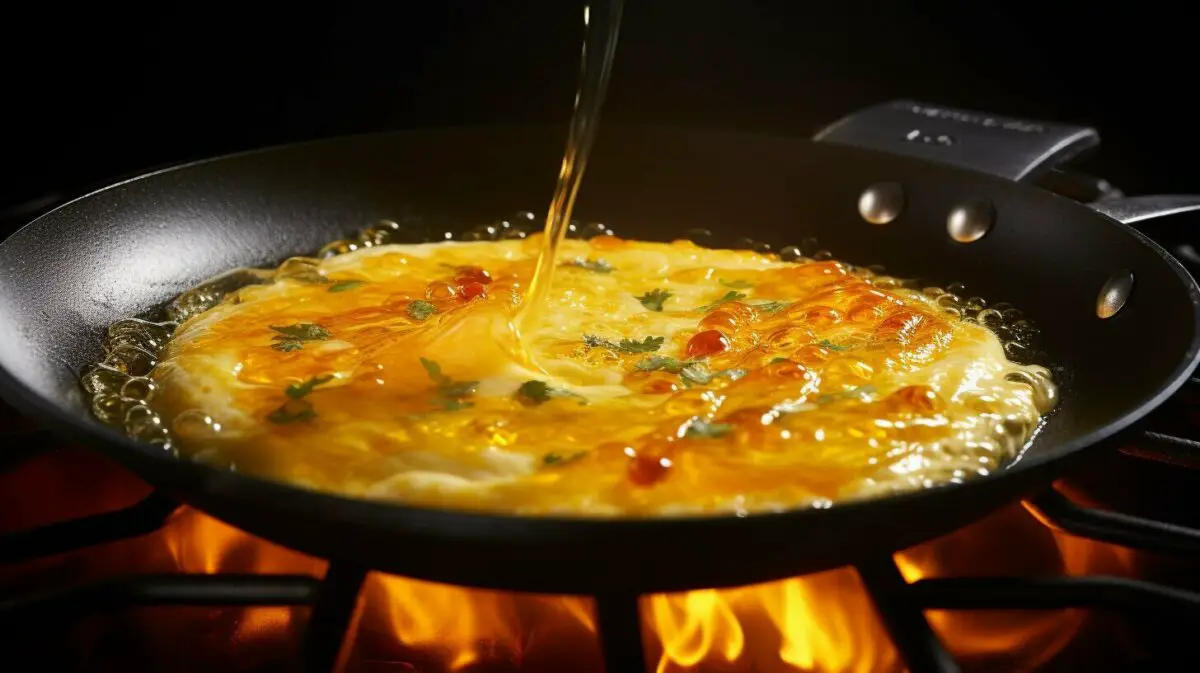
Once you have your pan and fillings ready, it’s time to start cooking. Remember to have everything prepped and within reach as omelettes cook quickly. With the right pan and a variety of delicious fillings, you’re well on your way to creating the perfect omelette!
Cooking Techniques: French vs. American Omelette
The cooking technique you choose will greatly impact the final result of your omelette, so let’s take a closer look at the differences between a French omelette and an American omelette. While both versions share the same basic concept of whisked eggs cooked in a pan, their preparation methods and textures diverge.
A French omelette is known for its delicate, silky texture and requires constant stirring throughout the cooking process. To make a French omelette, whisk together your eggs until well combined. Heat a nonstick skillet over medium-low heat and add a small amount of butter. Once the butter has melted, pour the whisked eggs into the pan and immediately begin stirring gently with a heat-proof rubber spatula. Stir continuously, lifting and folding the cooked edges into the center, until the eggs are softly set. This creates a thin, perfectly cooked omelette with no browning.
On the other hand, an American omelette is typically thicker and fluffier, with a slightly browned exterior. To make an American omelette, whisk together your eggs until well combined. Heat an 8-inch nonstick skillet over medium heat and add a small amount of oil or butter. Once the fat has melted, pour the whisked eggs into the pan and let them cook undisturbed until the bottom is golden brown. Use a heat-proof rubber spatula to carefully fold the omelette in half, creating a crescent shape. Cook for an additional minute to ensure the inside is fully cooked and the outside is lightly browned.
For those who prefer a lighter option, egg white omelettes are a popular choice. To make an egg white omelette, separate the egg whites from the yolks and whisk the whites until foamy. Heat a nonstick skillet over medium-low heat and add a small amount of oil or butter. Pour the whisked egg whites into the pan and let them cook undisturbed until set. To achieve a golden brown appearance, you can place the omelette under the broiler for a minute or two.
| French Omelette | American Omelette | Egg White Omelette |
|---|---|---|
| Delicate and silky texture | Thicker and fluffier texture | Light and airy texture |
| No browning | Lightly browned exterior | Lightly browned exterior (optional) |
| Constant stirring | Folded in half | Undisturbed cooking |
Understanding the differences between French and American omelettes allows you to choose the style that best suits your preferences. Whether you prefer a delicate, thin omelette or a hearty, fluffy one, mastering the cooking techniques will ensure your omelettes turn out just the way you like them.
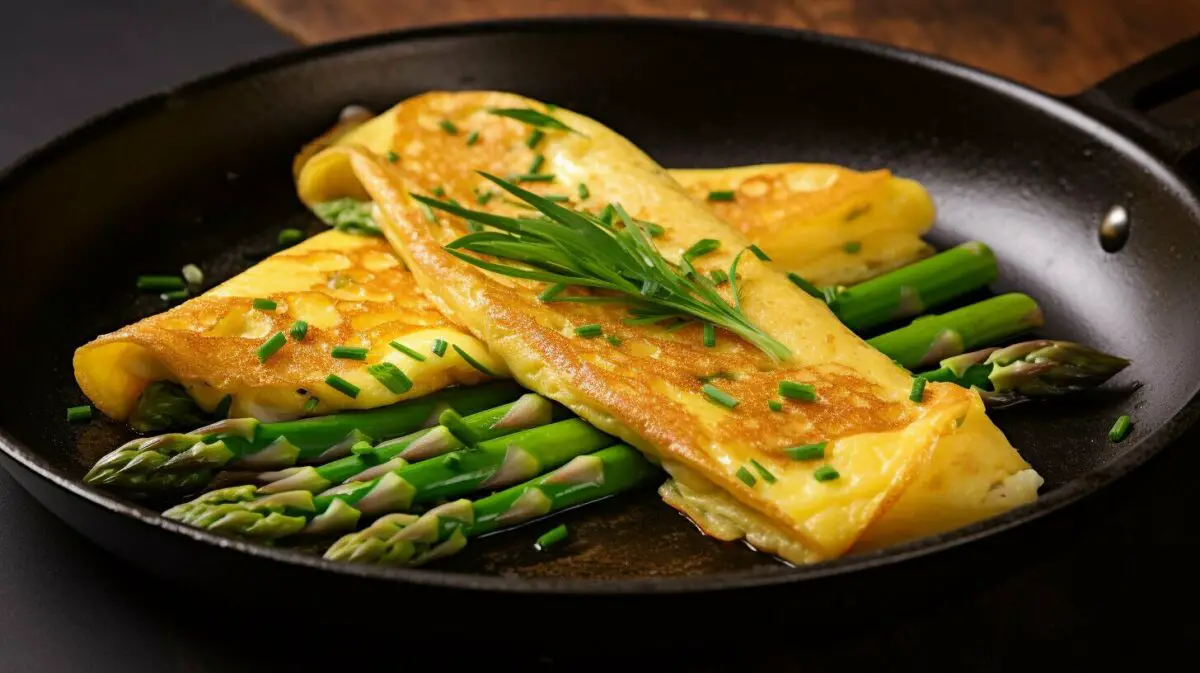
The French omelette is known for its thin and delicate texture, and it can be filled with a variety of ingredients to create a delicious and elegant dish. To make a perfect French omelette, start by whisking together eggs and a little water or milk in a bowl. This helps to create a light and fluffy texture.
Once the eggs are whisked, heat an 8-inch nonstick skillet over medium-low heat. Add some butter or oil to the skillet, allowing it to melt and coat the bottom evenly. Pour the whisked eggs into the skillet, and then immediately begin stirring the eggs with a heat-proof rubber spatula.
Continue stirring the eggs gently, moving the cooked portions from the edges towards the center. This technique ensures that the omelette cooks evenly and prevents any browning. When the eggs are almost set but still slightly runny on top, it’s time to add your fillings.
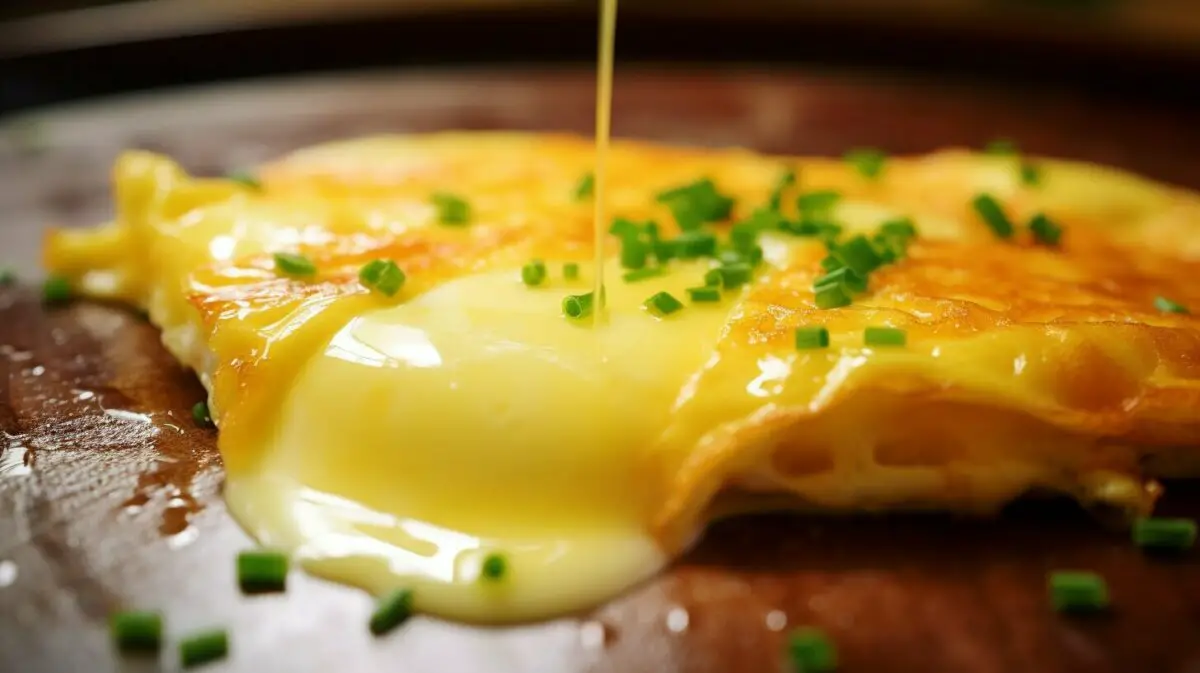
| Filling | Ingredients |
|---|---|
| Cheese | Cheddar, Swiss, Gruyere |
| Spinach | Fresh spinach leaves |
| Onion | Diced onion |
| Tomato | Sliced tomato |
| Ham | Diced ham |
Choose your favorite fillings, such as cheese, spinach, onion, tomato, or ham, and sprinkle them evenly over one half of the omelette. Gently fold the other half of the omelette over the fillings, forming a crescent shape. Cook for another minute or until the cheese has melted and the fillings are heated through.
Transfer the omelette to a plate, garnish with any additional toppings you desire, and serve immediately. The result is a beautifully folded, flavorful French omelette that is sure to impress.
Perfecting the American Omelette
If you prefer a thicker and more substantial omelette, the American-style is the way to go. Let’s discover the best fillings to create a satisfying breakfast or brunch dish.
To start, heat an 8-inch nonstick skillet over medium heat and add a pat of butter or a drizzle of cooking oil. Once the pan is hot and the fat has melted, pour in your whisked eggs and let them cook undisturbed for a few minutes until the bottom is lightly browned.
Now, it’s time to get creative with your fillings. One delicious option is to add crispy bacon for a smoky and savory flavor. Alternatively, try diced potatoes for a hearty and filling omelette. For a burst of color and sweetness, bell peppers are a fantastic choice. And if you like a little heat, jalapenos will add a spicy kick to your omelette.
Once your fillings are evenly distributed over the cooked eggs, use a heat-proof rubber spatula to carefully fold the omelette in half. Continue cooking for another minute or two, until the fillings are warmed through and any cheese has melted. Slide the omelette onto a plate, and it’s ready to be enjoyed!
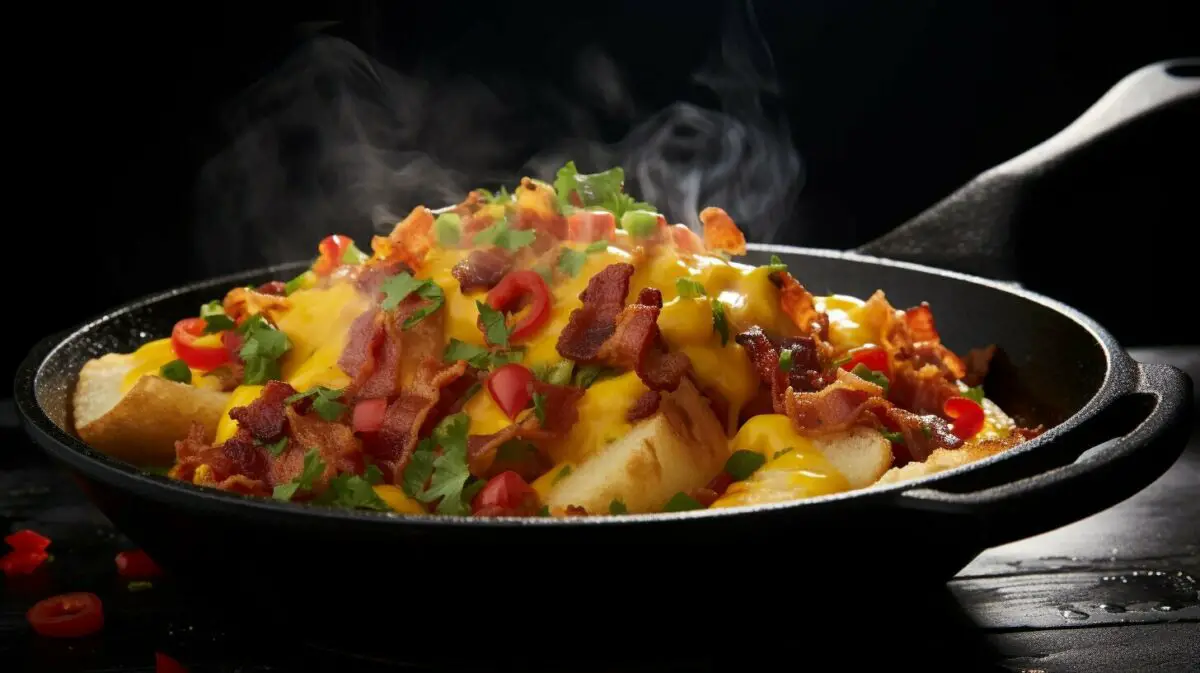
| Fillings | Taste | Texture |
|---|---|---|
| Bacon | Savory and smoky | Crisp |
| Potatoes | Hearty and filling | Tender |
| Bell Peppers | Sweet and vibrant | Crunchy |
| Jalapenos | Spicy and fiery | Tender |
“The American-style omelette is perfect for those who enjoy a thick and satisfying breakfast or brunch. The combination of fluffy eggs and flavorful fillings creates a delicious and hearty dish that will leave you satisfied until your next meal.”
Tips for Cooking Egg White Omelettes
If you’re looking for a lighter and healthier option, egg white omelettes are a great choice. Let’s explore some tips and variations for making them.
To start, whisk your egg whites until they become foamy. This helps incorporate air into them, resulting in a fluffy omelette. If you’re unsure about how much egg white to use, a general rule of thumb is that one large egg white is about 2 tablespoons or 1 fluid ounce. So, if you need to convert your egg whites to cups, remember that 1 cup is equal to 8 fluid ounces or 16 tablespoons.
When cooking your egg white omelette, it’s important to resist the temptation to stir or flip it too much. Unlike traditional omelettes, egg white omelettes cook best when left undisturbed. Cook on medium-low heat until the edges start to set and the center is slightly jiggly. Then, place the skillet under the broiler for a minute or two to give the top a nice browned finish.
Now, let’s talk about some delicious variations you can try with your egg white omelette. Feel free to get creative with your fillings! Some popular options include sautéed vegetables like spinach, mushrooms, and bell peppers. You can also add a sprinkle of low-fat cheese for added flavor. Experiment with different herbs and spices to customize your omelette to your taste.
| Variation | Ingredients |
|---|---|
| Vegetable Delight | Sautéed spinach, mushrooms, bell peppers |
| Mediterranean Twist | Diced tomatoes, feta cheese, fresh basil |
| Protein Power | Chopped grilled chicken, diced turkey bacon, diced onions |
Remember, the key to a successful egg white omelette is to avoid overcooking and to keep it light and fluffy. By following these tips and getting creative with your fillings, you’ll be able to enjoy a delicious and nutritious egg white omelette anytime.
Try this recipe for a tasty and nutritious Egg White Omelette:
- Whisk together 4 large egg whites until foamy.
- Heat a nonstick skillet over medium-low heat and coat with cooking spray or a small amount of olive oil.
- Pour the whisked egg whites into the skillet and let cook undisturbed until the edges start to set and the center is slightly jiggly.
- Place the skillet under the broiler for 1-2 minutes, or until the top is golden brown.
- Remove from the oven, fold in half, and serve with your favorite fillings.

Enjoy your egg white omelette with a side of fresh fruit or whole grain toast for a balanced and satisfying meal.
Omelette Size and Tools
Omelettes come in various sizes, so let’s find the perfect size for you and make sure you have the right tools on hand. The size of your omelette will depend on your personal preference and appetite. If you’re looking for a light breakfast or snack, a small omelette made with 2-3 eggs would be ideal. For a more substantial meal, opt for a larger omelette with 4-6 eggs.
Now let’s talk about the tools you’ll need to make the perfect omelette. The most important tool is a good quality nonstick skillet, preferably around 8 inches in size. This size allows for even cooking and easy flipping of the omelette. A heat-proof rubber spatula is also a must-have for gently folding and maneuvering the omelette without scratching the nonstick surface.
Other handy tools to have include a whisk for beating the eggs, a small bowl for whisking the eggs with any additions, and a cutting board for preparing your omelette fillings. Having these tools ready before you start cooking will make the process smoother and more enjoyable.
The Perfect Omelette Size and Tools
| Omelette Size | Number of Eggs | Skillet Size |
|---|---|---|
| Small | 2-3 eggs | 8 inches |
| Medium | 4-5 eggs | 10 inches |
| Large | 6-8 eggs | 12 inches |
Remember, the size of your omelette and the tools you use play a crucial role in its success. Experiment with different sizes and find what works best for you. Whether you prefer a small and delicate French omelette or a fluffy and hearty American omelette, having the right size and tools will ensure your omelette turns out perfectly every time.
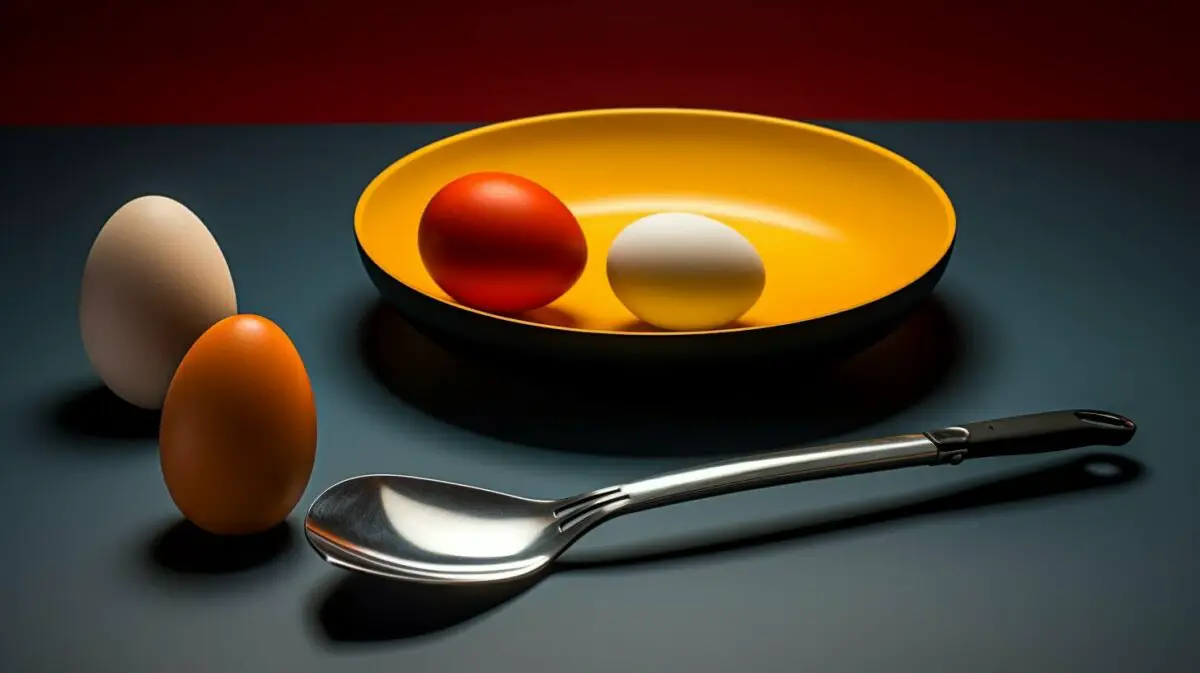
Quick and Easy Omelette Fillings
Omelettes are incredibly versatile and can be enjoyed at any time of the day. Let’s discover some tasty filling ideas to satisfy your cravings.
1. Bacon and Cheddar: Cook crispy bacon, crumble it, and sprinkle it over the omelette along with sharp cheddar cheese for a classic and savory combination.
2. Spinach and Feta: Sauté fresh spinach until wilted and fold it into the omelette along with crumbled feta cheese for a nutritious and flavorful option.
| Omelette Filling Ideas | Meal Time |
|---|---|
| 3. Ham and Swiss | Breakfast or Lunch |
| 4. Mushroom and Onion | Dinner |
| 5. Smoked Salmon and Cream Cheese | Brunch |
6. Veggie Delight: Sauté a mix of colorful bell peppers, onions, and zucchini. Add this medley to your omelette for a burst of freshness and crunch.
If you’re feeling adventurous, try experimenting with different herbs and spices to elevate your omelette’s flavor profile. A sprinkle of fresh herbs like chives, basil, or cilantro can make a world of difference.
The Perfect Omelette for Any Occasion
Whether you’re looking for a quick breakfast, a light lunch, or a satisfying dinner, omelettes can always deliver. With their endless filling possibilities, you can easily customize them to suit your taste buds and dietary preferences. So, why not whip up an omelette today and enjoy a delicious meal packed with protein and flavor?

Making an omelette is a skill that can be mastered with practice. Let’s explore some techniques that will help you become an omelette-making pro.
To start, whisk together your eggs with a little water or milk. This will make the eggs fluffy and light when cooked. The general rule of thumb is to use about 2 tablespoons of liquid per egg. Feel free to experiment with different ingredients like cream or even sour cream to add extra richness to your omelette.
Next, have your toppings ready before you start cooking. Omelettes cook quickly, so you want to make sure everything is prepared and within arm’s reach. Whether you prefer classic fillings like cheese, ham, and vegetables, or like to get creative with your flavor combinations, having your toppings ready will ensure a smooth cooking process.
The technique for cooking a French omelette is slightly different from an American omelette. For a French omelette, stir the eggs the entire time they are cooking. This creates a thin, delicate omelette with no browning. In contrast, an American omelette is cooked until thick and fluffy, with a beautiful golden brown color on the bottom. After cooking, it is folded in half for serving.
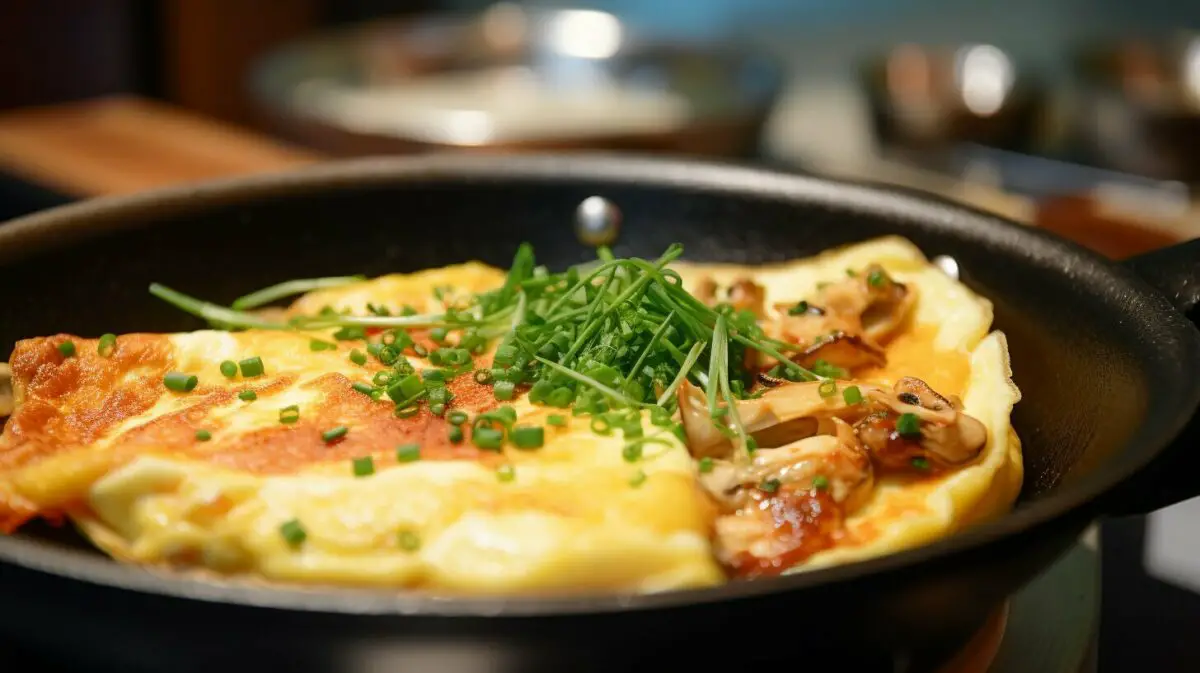
| French Omelette | American Omelette |
|---|---|
| Stir eggs continuously while cooking | Cook until thick and fluffy |
| No browning | Golden brown color on the bottom |
| Thin and delicate | Thick and fluffy |
For best results, use an 8-inch nonstick skillet and a heat-proof rubber spatula. The nonstick surface ensures that your omelette slides right out of the pan without sticking, while the heat-proof rubber spatula allows you to easily flip and fold your omelette without scratching the pan.
If you’re looking to make a healthier option, consider an egg white omelette. Whisk the egg whites until they become foamy before cooking. Cook them without stirring until set, and then broil until lightly browned on top. This technique results in a delicious omelette with a lower calorie and fat content.
Now that you’ve learned some key techniques, it’s time to put them into practice. With a little patience and experimentation, you’ll soon be making perfect omelettes like a pro.
Omelette Nutrition Facts
Omelettes not only taste delicious, but they also pack a nutritional punch. Let’s take a closer look at the nutritional benefits they offer.
When it comes to protein, omelettes are a fantastic choice. A typical omelette made with two eggs provides around 12 grams of protein, which is essential for muscle repair and growth. Protein also helps keep you feeling full and satisfied throughout the day, making omelettes a perfect breakfast option.
In addition to protein, omelettes are a good source of vitamins and minerals. Eggs contain a variety of nutrients such as vitamin B12, which supports brain function, and vitamin D, which helps with calcium absorption and keeps your bones strong. They also contain essential minerals like iron, zinc, and selenium, which are important for overall health and well-being.
| Nutrient | Amount per serving |
|---|---|
| Protein | 12g |
| Calcium | 32mg |
| Vitamin D | 0.8mcg |
| Vitamin B12 | 0.6mcg |
| Iron | 0.9mg |
| Zinc | 1mg |
| Selenium | 15.4mcg |
It’s important to note that the nutrition content of your omelette may vary based on the ingredients you use. Adding vegetables like spinach, bell peppers, tomatoes, and onions can increase the vitamin and mineral content of your omelette. Adding cheese, ham, or bacon will add additional protein and fat, so be mindful of portion sizes if you’re watching your calorie intake.
So the next time you whip up a delicious omelette, remember that not only are you treating your taste buds, but you’re also giving your body a boost of essential nutrients. Enjoy!

- United States Department of Agriculture (USDA)
- Healthline
- WebMD
Pro Tips for Perfect Omelettes
Now that you have the basics down, let’s dive into some expert tips that will elevate your omelette game. By incorporating these pro tips into your omelette-making routine, you’ll be able to create delicious and impressive omelettes that will leave your family and friends wanting more!
- Use a nonstick skillet: To prevent your omelette from sticking to the pan, it’s important to use a nonstick skillet. This will allow for easy flipping and ensure that your omelette comes out perfectly intact.
- Control the heat: Cooking omelettes requires a delicate balance of heat. Start with medium-low heat to gently cook the eggs, then increase it to medium-high when it’s time to brown the bottom. This will give you a beautifully cooked omelette with a golden crust.
- Add fillings at the right time: If you’re using any fillings in your omelette, such as vegetables or cheese, make sure to add them when the eggs are still slightly runny on top. This will allow the fillings to meld with the eggs as they finish cooking.
- Get creative with fillings: While classic fillings like cheese and ham are always delicious, don’t be afraid to get creative with your omelette fillings. Experiment with different combinations of vegetables, herbs, and proteins to discover unique and flavorful omelettes.

Finish off your omelette with a sprinkle of fresh herbs or a drizzle of hot sauce for an extra burst of flavor. Remember to serve your omelette immediately to enjoy it at its best. With these pro tips in mind, you’ll be well on your way to making omelettes that are not only visually appealing but also incredibly delicious. So, grab your spatula and start creating your own culinary masterpieces!
How to Make an Omelette – Conclusion
Congratulations on learning how to make a perfect omelette! With the right ingredients, techniques, and fillings, you can create delicious omelettes that will impress your family and friends. Now it’s time to grab your whisk and start cooking!
Remember, the key to a fluffy omelette is whisking the eggs with a little water or milk to make them light and airy. Make sure to have your fillings prepared beforehand, as omelettes cook quickly. If you prefer a thin, delicate omelette without browning, opt for the French style and stir the eggs continuously while cooking. On the other hand, if you prefer a thick and fluffy omelette with a golden crust, go for the American style and cook until set, browned on the bottom, and folded in half.
To achieve the best results, use an 8-inch nonstick skillet and a heat-proof rubber spatula. For those looking for a healthier option, you can also make an egg white omelette by whisking the egg whites until foamy, cooking without stirring until set, and broiling until browned. Experiment with different fillings, such as cheese, vegetables, meat, and herbs, to customize your omelette to your liking.
So, what are you waiting for? Get creative in the kitchen and enjoy the satisfaction of making a perfect omelette every time. Whether you’re making it for breakfast, lunch, dinner, or a snack, you can’t go wrong with this versatile and delicious dish. Happy cooking!
How to Make an Omelette – FAQ
Q: How do I make a perfect omelette?
A: To make a perfect omelette, whisk together eggs with a little water or milk to make them fluffy. Have your toppings ready before cooking, as omelettes cook quickly. For a French omelette, stir the eggs the entire time, resulting in a thin, delicate omelette with no browning. For an American omelette, cook until thick and fluffy, browned on the bottom, and folded in half. Use an 8-inch nonstick skillet and a heat-proof rubber spatula for best results. For an egg white omelette, whisk egg whites until foamy, cook without stirring until set, and then broil until browned.
Q: What are the essential ingredients for the perfect omelette?
A: The essential ingredients for a perfect omelette include eggs, butter or oil for cooking, and your choice of fillings such as cheese, vegetables, or meat. Seasonings like salt, pepper, and herbs can also be added for flavor.
Q: How should I whisk the eggs for fluffy results?
A: Whisk the eggs together with a little water or milk until they are well combined and slightly frothy. This will help incorporate air into the eggs, resulting in a fluffy texture when cooked.
Q: What do I need to do to prepare the pan and fillings?
A: Use an 8-inch nonstick skillet for cooking omelettes. Before adding the eggs, make sure the pan is heated and coated with butter or oil. Have your chosen fillings, such as vegetables, cheese, or meat, chopped and ready to add to the omelette once the eggs start to set.
Q: What are the differences between a French and American omelette?
A: A French omelette is cooked quickly over high heat, with the eggs constantly stirred to create a thin, delicate omelette with no browning. An American omelette, on the other hand, is cooked until thick and fluffy, browned on the bottom, and folded in half. The American omelette is heartier and often includes more fillings.
Q: How do I cook a French omelette?
A: To cook a French omelette, whisk the eggs with a little water and cook them in a hot nonstick skillet over high heat. Stir the eggs constantly until they are just set, creating a thin, delicate omelette.
Q: How do I cook an American omelette?
A: To cook an American omelette, whisk the eggs with a little water and cook them in a hot nonstick skillet over medium heat. Let the eggs cook until they are thick and fluffy, browned on the bottom, and then fold the omelette in half. This style of omelette is heartier and often includes more fillings.
Q: How do I make an egg white omelette?
A: To make an egg white omelette, separate the egg whites from the yolks and whisk the egg whites until they are foamy. Cook the egg whites in a hot nonstick skillet without stirring until they are set, and then broil the omelette until it is browned on top.
Q: What size pan should I use for making omelettes?
A: An 8-inch nonstick skillet is the ideal size for making omelettes. This size allows for even cooking and easy flipping or folding of the omelette.
Q: What are some quick and easy omelette fillings I can try?
A: Some quick and easy omelette fillings include cheese, vegetables like spinach, onion, and tomato, as well as meat like ham or bacon. Get creative and try different combinations to find your favorite!
Q: What are some pro tips for making perfect omelettes?
A: Some pro tips for making perfect omelettes include controlling the cooking temperature, using the right size pan, and practicing different folding techniques. Experiment with different fillings and cooking techniques to find what works best for you.
Our Friends:
Related Recipes:
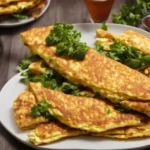 Omelette
Omelette
 Egg Freshness Test: Good or Bad?
Egg Freshness Test: Good or Bad?
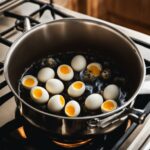 How Long To Boil Quail Eggs (Easy Step-by-Step Guide)
How Long To Boil Quail Eggs (Easy Step-by-Step Guide)
 How to Tell If Eggs Are Good (Easy Step-by-Step Guide)
How to Tell If Eggs Are Good (Easy Step-by-Step Guide)
 Turkey Filled Omelette
Turkey Filled Omelette
 How to Reheat Poached Eggs to Perfection
How to Reheat Poached Eggs to Perfection
 Goulash vs American Chop Suey: Breaking Down the Differences
Goulash vs American Chop Suey: Breaking Down the Differences
 How to Reheat French Fries: Crispy Every Time
How to Reheat French Fries: Crispy Every Time








